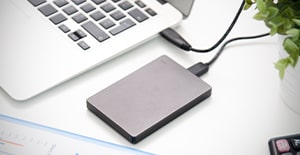How to Choose the Best Antivirus Software
Simplify your search for an antivirus software with this guide.
read morePublished on: August 1st, 2021

Data loss happens due to all kinds of reasons, including ransomware, viral attacks, human error, and so much more. Losing important files is more common than you think; in fact, about 140,000 hard drives crash every week in the United States. Knowing that you could lose all of your data is a scary thought, especially if you aren’t sure how to backup your entire computer.
We want to make having secure data easy and possible for everyone. So, we put together this three-step guide to help you better understand your backup options, so you never have to worry about losing precious files and memories.
You can use several external hard drives to backup your data, including USB flash drives, desktop hard drives, portable hard drives, and network-attached storage devices (NAS). Some external hard drives come with backup software that automates the process, making it easier for you. We will go into brief detail about the pros and cons of each.
USB Flash Drives have less storage space but are easy to store and highly portable. Due to the limited capacity, they are not well suited for backing up your entire computer.

Desktop hard drives provide ample space for system backups with many files. They are secure and make it easy to access individual files in case you lose or overwrite one. However, they require a power cord and are therefore not portable, so we would not recommend this for people who often travel for work or mostly rely on a laptop.
On the other hand, portable hard drives would be a great option for those who travel often and need to back up their computer away from home or the office. They don’t have as high of a data capacity as desktop hard drives and can be a bit slower, but you can use them in multiple locations.
Network-attached storage devices connect to your router and have ample space for multiple computers. They are more powerful and flexible but far more challenging to set up.
After acquiring an external hard drive, you will need to conduct a manual backup of your device.
If your computer uses the Windows operating system, select the Start button, go into the Control Panel, into System Maintenance, and then select Backup and Restore. From there, choose Set up backup and follow the instructions.
You also have the option of creating a system image. Image backup is more time-consuming since system files, program files, and preferences go into the backup too. If your computer drive fails, you can restore your computer exactly how it was onto a new computer or drive. This option doesn’t allow you to restore a few individual files at a time. To do this, choose Create a system image from the Backup and Restore page in the Control Panel.
If you use a Mac operating system, you will need to create a backup using Time Machine. After connecting your external storage device go to the Apple menu, then click System Preferences, and finally Time Machine. Choose Select Backup Disk and choose your external hard drive from the list of available options. Here you will have the opportunity to encrypt the drive, making it accessible only to those who have the backup password; just check the Encrypt backups checkbox. Then select Use Disk, and your backup will begin. Automated backups will occur if you keep the external drive plugged in.
When it comes to personal files and data, one backup isn’t enough. IT professionals swear by the 3-2-1 backup method. The method is to have three copies of your data: two storage devices, like your computer and an external hard drive, and one copy in an offsite location like the cloud.
There are many ways to save your data to the cloud. For instance, you can save individual files to cloud storage programs like Onedrive, iCloud, Google Drive, or DropBox. These sites offer limited space for free, so they are not optimal for backing up your entire computer. However, in the short-term, they can sync and share backup files between computers and users.
Then there are solutions for saving significant amounts of files like the data saved on an entire computer. Options vary between backups for commercial and at-home purposes.
Creating a backup for your entire file history can be time-consuming and a bit challenging if you’re working with multiple computers or lots of data. Computer Troubleshooters can make the process a lot easier for you with our commercial and residential data backup and recovery solutions. Find the nearest location to you so we can help you achieve peace of mind knowing you can restore your data whenever you need it.
Simplify your search for an antivirus software with this guide.
read moreHave you received this notorious Windows error screen? Here’s how to fix it.
read more© 2024 Computer Troubleshooters. Privacy Policy | Terms of Service | Accessibility Statement